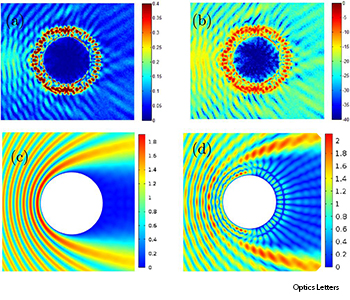
Electric-field-intensity distributions for a cloaked cylinder (top row) and an uncloaked cylinder (bottom row).
The Harry Potters of the future may not need to wait for someone to give them an invisibility cloak. Instead, they might just go to the nearest 3-D printer to make their own.
Using a type of polymer-based 3-D printing, researchers at Duke University (U.S.A.) fabricated a free-space cloaking disk that suppresses scattering from a conducting cylinder at microwave frequencies (Opt. Lett. 38, 1606).
The printing technique selected by researcher Yaroslav Urzhumov and his colleagues is known as fused deposition modeling, stereolithographic polymer-based fabrication, additive manufacturing or simply 3-D printing. Such a printer lays down successive layers of a plastic material to build up a shape as directed by a digital model. Manufacturers use the technology for rapid product prototyping, but as printer prices have dropped, other users have embraced it as well.
In this case, the Duke team used computer simulations to draw plans for a ring-shaped disk that would act as a cloak against 10-GHz microwaves. The ring had an outer diameter of 198 mm, an inner diameter of 138 mm, and a calculated pattern of holes in between. The researchers eliminated holes smaller than 0.8 mm wide from the calculations, since that was the resolution limit of the printer. Then they “printed” a copy of the ring from acrylonitrile butadiene styrene, whose dielectric properties in the microwave X-band (8-12 GHz) they had already measured.
By mapping the electric-field intensity of the dielectric ring as it surrounded a conducting cylinder, the researchers determined that it had only a negligible “shadow” in the 10-GHz beam.
Like most innovations in transformation optics, the printed cloaking device now works only at microwave frequencies. However, the scientists say that, because the polymer has a relatively low dielectric constant and refractive index, the technique should scale well to optical frequencies.
Two researchers from the University of California at San Diego (U.S.A.) also worked on the project.
